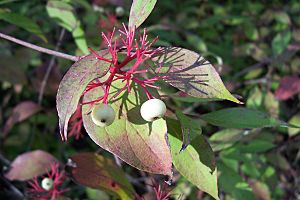Red osier facts for kids
Cornus sericea, also known as red osier or red-osier dogwood, is a type of flowering plant. It belongs to the Cornaceae family. This plant grows naturally across northern and western North America. You can find it from Alaska to Newfoundland, and south into Mexico. It's sometimes called red brush, red willow, or redstem dogwood.
Quick facts for kids Red osier |
|
|---|---|
 |
|
| Red osier dogwood bearing fruit | |
| Scientific classification | |
| Genus: |
Cornus
|
| Species: |
sericea
|
 |
|
| Natural range of subsp. sericea | |
 |
|
| Natural range of subsp. occidentalis | |
Contents
What it Looks Like
The Red Osier Dogwood is a medium to tall deciduous shrub. This means it's a woody plant that loses its leaves in the fall. It usually grows in wet places, like wetlands.
It can grow from about 1.5 to 4 meters (5 to 13 feet) tall. It spreads out 3 to 5 meters (10 to 16 feet) wide. It spreads easily using underground stems called stolons. This helps it form thick groups of plants.
The branches and twigs are often a bright dark red color. However, plants in shady areas might not be as red. Its leaves grow in pairs, one across from the other. They are 5 to 12 centimeters (2 to 5 inches) long. The leaves are dark green on top and a bit pale or "frosted" (called glaucous) underneath. In the fall, the leaves turn bright red or purple.
The plant's flowers are small and dull white. They grow in clusters that are 3 to 6 centimeters (1 to 2 inches) wide. The fruit is a round, white berry. Each berry is about 5 to 9 millimeters (0.2 to 0.35 inches) wide.
The scientific name sericea means "silky." This refers to how the leaves feel.
Growing Red Osier Dogwood
Red Osier Dogwood is a popular plant for gardens. People like to plant it because its twigs turn bright red in winter. This adds a splash of color when other plants are bare. Some special types, called cultivars, are grown for their unique colors. For example, 'Bud's Yellow' has yellow stems, and 'Flaviramea' has lime green stems.
Sometimes, a bug called the dogwood sawfly might eat the leaves of the plant. If this happens, the plant might lose many of its leaves. You can pick the larvae (young bugs) off the plant by hand to help protect it.
Uses of the Plant
Red Osier Dogwood is often used to protect riverbanks and lake shores. Its strong root system helps hold the soil in place. This stops the land from washing away. It's a tough plant that looks good even in winter. Because it can grow from cuttings, it's a cheap way to plant many shrubs at once.
Some Native American tribes used the berries of this plant. They would eat them to help with colds or to slow down bleeding.
The inner bark of the plant was also used by some tribes, like the Lakota. They called it cansasa. They used it as "traditional tobacco," sometimes by itself or mixed with other plants. The Ojibwe people mixed the inner bark with tobacco to make smoking mixtures called kinnikinnick. Other tribes added it to bearberry leaves to make them taste better.
The Ojibwe also used the inner bark of the red-osier dogwood as a dye. They would mix it with other plants or minerals to create colors.
The flexible branches, called withies or osiers, are also used to make baskets.
Types of Red Osier Dogwood
There are two main types, or subspecies, of Red Osier Dogwood:
- Cornus sericea subsp. sericea: This type is found throughout the plant's whole range. Its shoots and leaves are mostly smooth or have very fine hairs. Its flower petals are small, about 2–3 millimeters long.
- Cornus sericea subsp. occidentalis: This type grows in western North America. Its shoots and leaves have more dense hairs. Its flower petals are a bit larger, about 3–4.5 millimeters long.
Images for kids
See also
 In Spanish: Cornus sericea para niños
In Spanish: Cornus sericea para niños












